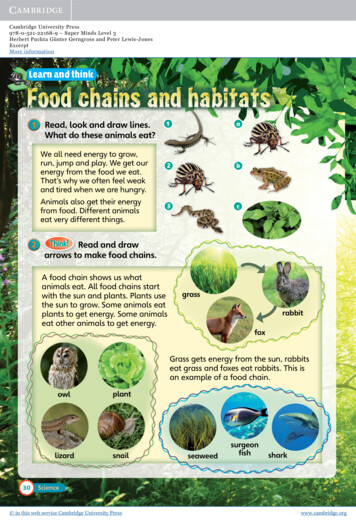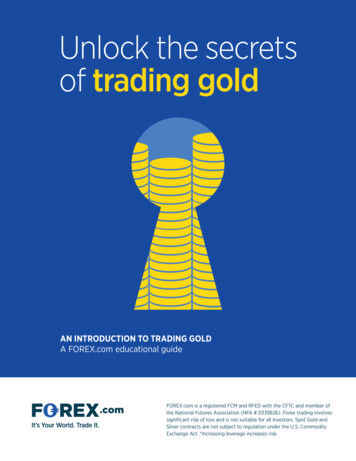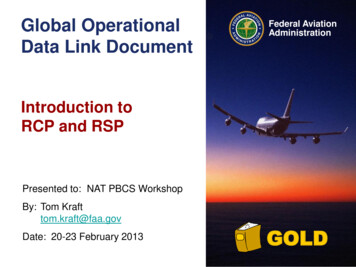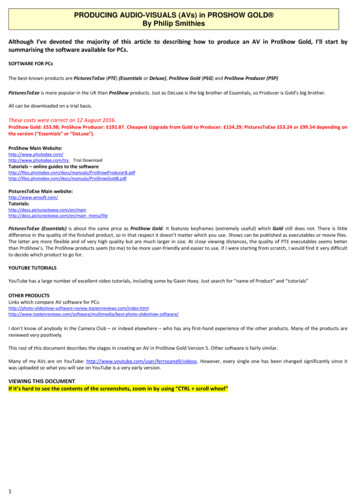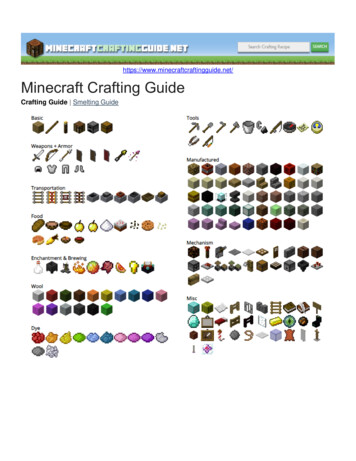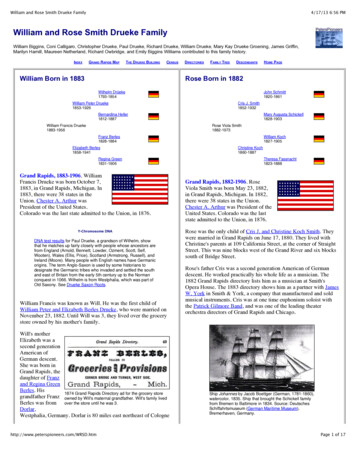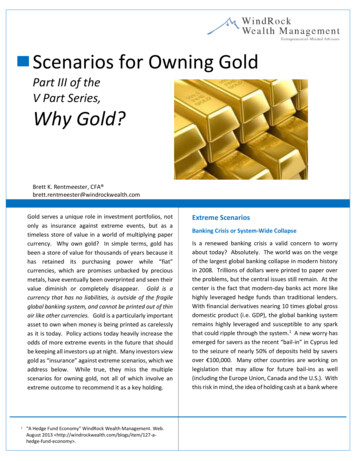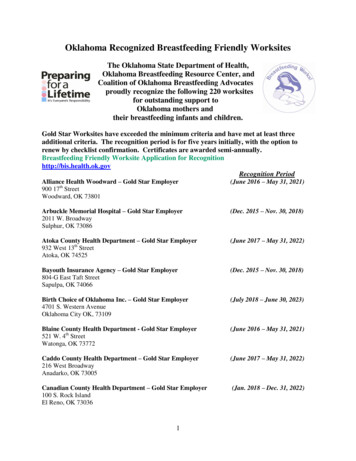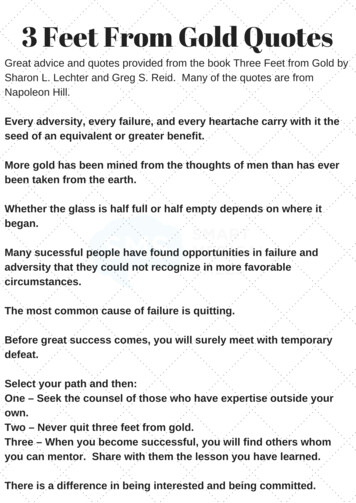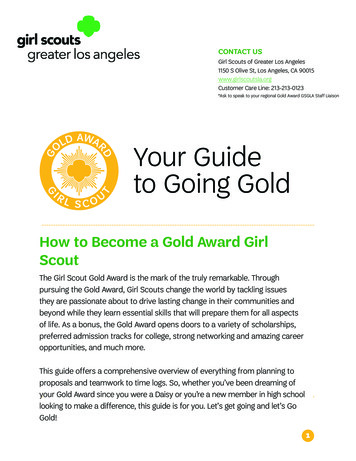
Transcription
CONTACT USGirl Scouts of Greater Los Angeles1150 S Olive St, Los Angeles, CA 90015www.girlscoutsla.orgCustomer Care Line: 213-213-0123*Ask to speak to your regional Gold Award GSGLA Staff LiaisonYour Guideto Going GoldHow to Become a Gold Award GirlScoutThe Girl Scout Gold Award is the mark of the truly remarkable. Throughpursuing the Gold Award, Girl Scouts change the world by tackling issuesthey are passionate about to drive lasting change in their communities andbeyond while they learn essential skills that will prepare them for all aspectsof life. As a bonus, the Gold Award opens doors to a variety of scholarships,preferred admission tracks for college, strong networking and amazing careeropportunities, and much more.This guide offers a comprehensive overview of everything from planning toproposals and teamwork to time logs. So, whether you’ve been dreaming ofyour Gold Award since you were a Daisy or you’re a new member in high schoollooking to make a difference, this guide is for you. Let’s get going and let’s GoGold!1
ContentsPart I: The Gold Award Defined The benefits of becoming a Gold Award GirlScout 3 Key elements of the Gold Award 4 What does “take action” really mean? 4 What’s the difference betweencommunity service and aTake Action project? 4 What is a root cause? 5 How do I include a national and/or globallink in my project? 5 How do I show leadership in my project? 6 What does a sustainable project looklike? 6 How do I measure my impact? 7 How do I earn money for my project? 15 Can I use media to share my project? 15 What do I need to know about safety? 15 Step 5: Present your plan 15-16 Proposal review and approval process 16 Step 6: Take action 16 What if I need to modify my project? 16 Step 7: Educate and inspire 16 Final report review and approval process 17 Congratulations—you’re a Gold Award GirlScout! 17Part 2: Achieving Your Gold Award Share your accomplishment with the world! 17-18 How do I know I’m ready? 9 Opportunities for Gold Award Girl Scouts How do I know what to do—and when? 9 When is the Gold Award ceremony? 19 How much time does it take? 9-10 Tournament Troop 19 What is the GoGold web app? 10 GSGLA Gold Award Standards 20 What are the #1 tips to help me succeed? 11 Our resource roundup for Girl Scouts 41 What are the seven steps to the Gold Award? 12 GSGLA resources 41 Step 1: Choose an issue 12 NEW GSUSA Project Proposal Rubric 42 Step 2: Investigate 12-13 Step 3: Get help 14 Council staff Step 4: Create a plan 15 2020 Girl Scouts of the USA.All rights reserved. No part of this publication may be reproduced,distributed, or transmitted in any form or by any means, electronicor mechanical methods, including photocopying, recording, or by anyinformation storage or retrieval system, now known or hereinafter invented,without the prior written permission of Girl Scouts of the United States ofAmerica, except in the case of brief quotations embodied in critical reviewsand certain other noncommercial uses permitted by copyright law. Forpermissions requests, write to Girl Scouts of the United States of America atthe address below or visit the www.girlscouts.org website to accesspermission request forms.First published in 2020 byGirl Scouts of the United States of America420 Fifth Avenue, New York, NY 10018-2798www.girlscouts.org2
Part 1: The Gold Award DefinedCurious about the Gold Award? Read on to learn more about what it means and how you’ll lead lastingchange in your community.The benefits of becominga Gold Award Girl ScoutWhen you become a Gold Award Girl Scout, you delve deep intoyour passions, flex your problem-solving muscle, stand up for whatyou believe in, inspire others, and make a difference. It’s anopportunity to do something more and to set your sights on trueleadership.Here are a few other reasons to Go Gold: Grow professional skills. Gold Award Girl Scouts becomepros in team building, problem solving, project planning, andtime management. These are invaluable skills that allprofessionals need—and all people value. You can highlightthese experiences as you apply to schools, jobs, internships,and other opportunities. Earn scholarships. Many universities and colleges awardscholarships to Gold Award Girl Scouts. Build your network. Gold Award Girl Scouts recruit andlead teams to do amazing things! This experience will giveyou a network of supporters that lasts a lifetime. Enlist at a higher pay grade when you join the military.SOMETHING TOthis forREMEMBER: Done else!you—not for anyont’s or troopThis isn’t your paree Gold Award isleader’s project. Thharness youran opportunity tour ideas intopassion and put yoging. It’smotion. It’s challening. And it’simmensely rewardentirely up to you.SOMETHING TOREMEMBER: Once you’veearned the Gold Award, youcan proudly claim your Gold Awarddigital credential from Credly, ourverification partner! You candisplay it on your social mediaprofiles, including LinkedIn. Thisallows prospective employers,universities/colleges, militaryacademies, and others to verifyyour achievement simply byviewing your profile.3
Key elements of the Gold AwardThe Girl Scout Gold Award is a Take Action project that must includefive elements. Your project must (1) address a root cause of an issue that youfeel passionate about that has a (2) national and/or global link. Through youractions, you must demonstrate (3) leadership while also creating(4) sustainable and (5) measurable impact.What does “take action” really mean?Taking action means working to understand the root cause of a problem so that you can develop asolution that continues to address that issue—even after your Gold Award project has been completed.Simply put, taking action goes beyond community service.WHAT’S THE DIFFERENCE BETWEEN COMMUNITYSERVICE AND A TAKE ACTION PROJECT?Take Action and community service projects are different, andboth are essential to Girl Scouting. When you earn the Gold Award,you are transformed from living the Girl Scout Law to bringing it tolife!Community service projects are acts of kindness and importantways to help something or someone right now. They arecommonly “one and done” activities. Performing communityservice almost always multiplies efforts that are already in place.Examples include collecting food for an existing food pantry,providing clothing or toiletries for people who have suffered adisaster, cleaning up a run-down playground, or picking up trash ata park, forest, or beach.SOMETHING TOREMEMBER: Collecting,beautifying, decorating, andcleaning can be part ofa TakeAction project; howevertheseactivities are not stand-alone GoldAward projects. Stay focused onunique solutions with long-termrelief.Girl Scout Take Action projects address an issue by tackling the factors that cause or contribute to it.As you may expect, these projects have a far-reaching impact. They are designed to change somethingfor the better—forever.Use this table to help determine whether an idea is a community service or Take Action project.Community ServiceTake ActionA short-term effort that helps something or someonefulfill an immediate needA long-term project with sustainable and ongoingimpact that addresses a root cause of an issueDone FOR the communityDone WITH the communityJoining an existing effort to solve a problemCreating a unique initiative to address an issueDone as part of an existing team (usually as avolunteer)Creating and leading your own team of volunteersWorking towards a goal that’s set by othersSetting the goals and leading a team to achieve them4
What is a root cause?Root causes are an issue’s trigger—they identify why an issue is happening. Often, you’ll have to look forthe why in a lot of places in order to get to the root causes. Once you’ve identified your issue, you cancreate a “mind map” in GoGold, the Gold Award web app (learn more about GoGold). This will help youfind its root causes. A mind map can help you understand what triggers your issue and will help you lookfurther to find the root causes of those triggers.ROOT CAUSE EXAMPLE: Rachel is passionate about ocean conservation. She asks why oceanpollution happens and lists several causes, including acid rain, soil runoff, and oil spills. Sheremembers witnessing the harmful impact of a major oil spill in her local ecosystem and decides tolearn more about why oil spills happen. Rachel reaches out to experts and, after additional research,learns that a lack of safety protocols for oil storage is one of the root causes. She chooses to create aproject that addresses how oil storage can be made safer to prevent spills.Step 2: Investigate will walk you through how to use a mind map and then research your issue’s rootcauses. When you’re ready, visit Step 2 of GoGold to do it yourself!How do I include a national and/or global link in my project?Identifying a national and/or global link doesn’t mean you need to travel or expand your project across theglobe. It’s likely that the issue you’ve been working towards addressing is relevant worldwide—it can befound in your own local, regional, or national community and across the globe, whether it’s poverty,hunger, illiteracy, homelessness, or pollution.Research how other areas, communities, or countries address your issue. Seeing how other people andplaces implement solutions might inspire your actions and will absolutely show you a national or globalconnection. Consider reaching out, explaining your ideas, and asking for their advice, ideas, and evencollaboration. You can use what you learn to inform your project. Plus, these kinds of partnerships can beexcellent ways to ensure your project’s sustainability.NATIONAL AND/OR GLOBAL LINK EXAMPLE: For the past four years, Maria has volunteered ata local animal rescue group. It regularly operates at its maximum capacity and is unable to take inadditional animals. Maria decides to tackle one of the root causes of this issue for her Gold Award.As she begins her research, she learns that animal rescue groups across the country share similarchallenges and discovers various perspectives on animal welfare across the globe. Then, she reachesout to relevant animal welfare organizations to better understand the issue and to access the researchthat they have available. She decides to focus on a solution that she can implement at animal rescuegroups in her community and share widely.Visit Step 4 of GoGold to identify your issue’s national and/or global link. Be sure to include researchthat backs it up!5
How do I show leadership in my project?It isn’t a leader’s job to do everything; rather, it’s the leader’s job to make sure everything gets done. Youwill demonstrate leadership by recruiting and engaging a diverse team of volunteers from your networkand around the community. Share your vision to help align your team—you can also map out activities,set schedules, create a communication plan, and solve challenges if they arise.Take Action projects require partnering with the community you’re serving, so be sure to enlistappropriate individuals, groups, or organizations before, during, and after your project to ensure they areengaged with and benefit from your project. Ideally, your project will provide the community you servewith a much-needed solution, so they will help sustain your project.**NOTE** GSGLA requires that girls have at least one community organization signed on as a mainrecipient or partner for their project.LEADERSHIP EXAMPLE: Caitlin elevated her passion for theater to raise awareness aboutsubstance abuse issues among high school students. She reached out to her high school’s dramaclub for volunteer actors and backstage crew members. She found volunteers within her Girl Scouttroop to design and distribute promotional materials for performances.At a local drug abuse education nonprofit, Caitlin learned about the extent of substance abuse in hertown and found her project advisor. Her advisor connected her with volunteer educators whoinformed the educational components of Caitlin’s project and hosted talk-backs after performances.Finally, Caitlin engaged other high school drama clubs to ensure that the program continued toreach her target audience.Step 3: Get Help features important members of your team and the roles they might play. Whenyou’re ready, visit Step 3 of GoGold to list your team members and share how you plan to lead themas you implement your project.What does a sustainable project look like?Sustainability means that your project, as well as the work towards addressing your issue, carries onor continues even after you’ve done your part and earned the Gold Award. In a nutshell: you’ll put aplan in place that ensures your Gold Award creates lasting change.Sustainability is not one-size-fits-all. Here are three different ways you can ensure your project issustainable:1 Create a permanent solution . and ensure it’s used.Short project descriptionHow you know it’s sustained .Brand-new girls wrestling teamat your schoolGet a letter of commitment from your school administration to sustain theteamCultural competency club at alocal community centerProvide a how-to manual with guidelines and your organization charter tothe community center so they can maintain your project after you wrap upFormal-wear lending boutiquefor military familiesEstablish a system for rotating and refreshing available items that outlastsyour support6
2 Educate others by inspiring them to change their attitudes, beliefs, or behaviors and provethe changes by using a measurement tool and either 1) putting a plan in place to continue theeducation beyond your involvement or 2) enacting a call to action.Short project descriptionHow you know it’s sustained .Stress-relief awarenesscampaignCollect pre- and post-surveys tomeasure change in your audience’sknowledge and perceptions and enacta call to action, like a pledge, to trackwho commits to adopting new selfcare habitsReading workshops to promoteearly literacyCollect pre- and post-surveys tomeasure how audience reading skillsimprove and share the curriculumwith a community partner to continueliteracy educationSchool recycling presentationsCollect pre- and post-surveys to measure increase in recycling knowhow and enact a call to action, like an online tracking system to count thenumber of students recycling at the school and total pounds of recycledmaterial annuallySOMETHING TOREMEMBER: When yourgoal is to changesomeone’s mind, education can bea powerful tool. You can create anddeploy a wide range of materialsthat will educate others about theissue you care about. We call this a“force multiplier” when someonemakes a significant change to anattitude and/or behavior.3 Advocate to change a rule, regulation, or law . and engage others in your advocacy.Short project descriptionHow you know it’s sustained .Protecting sea turtle habitatsGet others to take up the cause by signing a petition as part of a campaignto enact a law that protects the animals’ habitats. Your advocacy is whatmatters—bonus points if you get a law passed, but even if you don’t, you canstill change minds and behavior along the way.Visit Step 4 GoGold to plan your project’s sustainability.How do I measure my impact?Your impact is measurable when you collect information or data throughout your project and use it toshow that your actions have had a positive effect on the community and/or contributed to addressingyour issue.Think about what you can count in order to measure the effectiveness of your project. This means thatyou will need to set a goal or two! That way, when you measure your results, you’ll know how effectiveyour project was overall. Goals can feel intimidating, but remember, you’re setting them for yourself—andthey are adaptable.You can begin demonstrating your impact by asking “how much?” or “how many?” You can count how many people your project helped, involved, or educated, or how manypeople changed their behavior or attitudes. You can also count the number of members in a group(social media or in person) or how may clicks, shares, views, or comments your website or postsreceived.7
If you are introducing a new concept to a group, you can use a pre- and post-questionnaireto measure how much they’ve learned or assess what behaviors they’ve changed.Successful Gold Award projects have goals and measure true impact. Be confident in setting andmeasuring multiple goals, so you can understand the impact of each part of your project. And don’t be shyabout expanding your efforts as you go!MEASUREMENT EXAMPLE: Nancy is creating a technology classfor women in the prison system to help prepare them for futureemployment. She sets two goals: to reach 50 women in the prisonsystem with her technology class by the end of the school year andto be sure at least 75% of the women feel like they have increasedtheir tech skills. To measure her impact, she plans to use two metrics:she will track participation to ensure she serves at least 50 women,and she will circulate questionnaires before and after the classesto assess if her participants are increasing their tech skills. Byconsistently tracking her progress, she can adjust her plan tobetter meet her goals.Visit Step 4 of GoGold to create your project’s goals and outlinehow you’ll measure your impact.SOMETHING TOREMEMBER: While goalsare important guidelines,they may change as yougo along.It’s OK—it’s all part of thelearningprocess. Collecting andanalyzingdata throughout your project willhelp you gauge the impact yourproject is having, makeimprovements and adjust yourgoals as necessary, and ultimatelytell a compelling storyabout yourGold Award. If you thinkyou needto change your goals after yourproposal has been approved, reachout to your council contact foradvice and support.8
Part 2: Achieving Your Gold AwardNow that you’ve learned about the Gold Award, you’re ready to earn it—the greatest achievement in GirlScouting! It may sound daunting, but we’ll break it down into smaller, more manageable steps. Read onfor more on how to get started. And remember: your council and the Girl Scout Movement will be thereto support you every step of the way!How do I know I’m ready?You can begin working on your Gold Award proposal in GoGold after you’ve crossed certain items offyour to-do list. You’re ready when: You’re in grades 9–12. You’re a registered Girl Scout Senior or Ambassador. You’ve completed two Senior or Ambassador Journeys OR have earned a Silver Award andcompleted one Senior or Ambassador Journey. You feel compelled to do something meaningful that will make the world a better place!How do I know what to do—and when?Once you have completed your Gold Award prerequisites, you must complete the mandatory GSGLA GoldAward Workshop. Workshops are offered on a monthly basis. Please visit the GSGLA website to register for aworkshop.How much time does it take?Plan to spend 80 hours and 3-months bringing your project to life—that’s the minimum standard. Thesehours will give you the time you need to properly plan and execute your project—though keep in mind thatyour schedule and other time commitments willinfluence how long it takes to complete your project. This is OK,BUDGET YOUR HOURSwhatever timeline you follow is just fine!LeadershipUse this chart—and the definitions below—as a guide to help youplan how to best invest your time for maximum efficiency andimpact. Preparation (30–50%) includes time planning pre- and postapproval. Pre-approval (up to 10 hours/12%) is the process of preparingyour project plan before council review and approval. Thisincludes some research, contacting possible community partners,investigating potential venues, finding prospective volunteers, andultimately completing your project proposal. Post-approval (up to 40%) is the work of finalizing yourresearch and locking in your logistics after your proposal isapproved by your council. For example, you might contact yourvenue and set dates and times for workshops.Preparation30–50%Wrap Up& ��15%*If Needed9
Implementation (30–50%) is the process of leading and executing the plan you defined in your projectproposal and making changes, when necessary, to achieve the project’s goal. This includes training yourvolunteers, leading your team to do your project, and more! Earning money (5–15%) is optional, and only includes time you spend earning money for your Gold Award. Wrap Up & Thanks (5–10%) includes reflecting on your impact and appreciating your team, which areessential parts of the Gold Award, so make these a priority as you wrap up.It’s easy to forget an activity, email, or conversation, so use the “Track My Work” tab in GoGold to make sureyou don’t miss a thing.What is the GoGold web app?GoGold is a mobile-friendly web app you will use to track your progress towards completing the sevensteps of the Gold Award—from idea to proposal, to taking action and final report—online!You can use GoGold to brainstorm and submit your official Gold Award proposal as well as yourfinal report. This system is designed with you in mind. It offers a lot more than just a place to uploaddocuments.GoGold takes you through each of the Gold Award steps while offering new ways to examine the issueyou want to work on and its root causes, plan your project, set goals, map a timeline, and add your teammembers.The functionality built into GoGold is going to save you time, too. The system includes options for yourtroop leader to virtually sign off on your prerequisites, like your completed Journeys or Silver Award, andfor your project advisor to verify your proposal is ready for your council’s review process. (We will tell youmore about the role of a project advisor in Step 3.)Think of GoGold as an interactive, informative, and enormous filing cabinet up in the cloud—where everysingle Gold Award proposal and final report is proudly safeguarded and catalogued for all the Girl Scoutswho are on this amazing journey.10
What are the #1 tips to help me succeed?DO THISNOT THISPull a team of volunteers together and put yourleadership skills to work.Do it all yourself with just a few or no volunteers.Choose a project advisor who is an expert on yourissue and willing to be involved.Choose a parent or troop leader as an advisor.Plan ahead and anticipate obstacles.Wing it without a plan.Break up your work into small, manageable bundlesand assign each bundle a timeline.Procrastinate or try to do it all at once.Update your project advisor and council contact andask questions when needed.Keep project progress, obstacles, and details toyourself until you submit your final report.Document everything as it occurs so that theinformation you collect is accurate and honest.Make up a timeline after you’ve finished the project orput together several small projects.Measure your project’s outcome—you can alwayslook to your council contact for guidance on collectingdata, conducting surveys, and doing pre- and postevaluations.Complete your project with no real way to measurethe impact you’ve made.Make sure your project includes the five Gold Awardelements.Submit your project proposal without addressingroot cause or including a national and/or global link,sustainability, measurability, or leadership.Include detailed goals in your project proposal thatshow your anticipated impact.Skip goal setting.Do research to make sure any organizations you planto work with want to sustain your project.Assume that organizations need your help.Create a dynamic project with measurable impact ona community.Create a static website as the focus of your project orhold a one-day workshop.Be original—this is your chance to shine!Copy what others have done.11
What are the seven steps to the Gold Award? Step 1: Choose an issue Step 2: Investigate Step 3: Get help Step 4: Create a plan Step 5: Present your plan Step 6: Take action Step 7: Educate and inspireLet’s break it down with a description of each step and tips for success. You’ll complete these stepsusing GoGold. When you’re ready, create a GoGold account and get started!Step 1: Choose an issueIn this step, you’ll answer questions that will help you reflect on your personal values, education,experience, and interests in order to find an issue you care about.Use the interactive question tree in GoGold to answer a series of questions that will help you explore howto merge your passions and skills to take action. It’s easy! Simply answer the questions and GoGold willdo the rest, compiling your responses into project themes that may interest you.Why?Why are youinspired? Do youcare about poverty,women’s rights,environmentalsustainability, healthand relationships,animals, humanrights, veterans,sports, or somethingelse?Who?Who do you wantto help? The elderly,children, thoseless fortunate,nature, peoplewith disabilities, oranimals?Where?Where do you wantto make an impact?Your school,neighborhood, city,state, country, oraround the world?What?What are yourstrengths andtalents? Publicspeaking, math,community building,empathy, research,or people skills?How?How do you want tomake a difference?Will you change alaw, lead workshops,start a club, developcurriculum, givepresentations, teacha skill, or take actionanother way?You can complete the quiz as many times as you want. And you’ll leave the step with an issue or two youmay want to explore further.Step 2: InvestigateIn Step 1, you identified a community issue or two that you’re interested in exploring further. You’ll need totrace back the issues to their root causes for your project and then connect with issue experts to planyour project. By addressing the root causes of your issue and involving your community in the solution,you’ll be primed to make a sustainable impact.12
Start by using a mind-mapping tool to explore the root causes of the issue you’ve chosen. Here’san example mind map (see blank example on pg 45):Missed opportunity to combinecommunity/school resourcesinto extracurricular programsNot enoughawareness aboutits proven benefitsNot enoughawareness aboutcareer opportunitiesin the artsPublicperceptionNo local policy protectingarts programs in schoolsCurriculum structureLACK OFARTSEDUCATIONIN SCHOOLSPublic policyMany schools don’t integratethe arts into STEM (Science,Technology, Engineering,and Math) programsOften not includedin school budgetsFundingMissedopportunitiesfor communitypartnershipsNo state laws protectingarts programs in schoolsNotice that the community issue “lack of arts education in schools” is placed in the center and that thingsthat trigger it, like funding, public policy, public perception, and curriculum structure are explored further.When you explore further, you find root causes. In this example, the root causes are in the outer prongs.For example, the root causes of the public’s perception of lack of arts education in schools include notenough awareness about proven benefits and not enough awareness about career opportunities in thearts.Once you’ve identified root causes, take your research further to make sure: You’ve identified a real need in the community. You can make your project idea happen—it’s realistic. You can learn about resources and develop a network beyond your friends and family to help you.Get online. Check news and organizations’ sites related to your issue. Explore how the media in othercountries cover your issue.Get reading. Find books that offer in-depth analysis of your issue, read your local newspaper, and lookfor magazine articles that offer different perspectives.Interview experts. Talk to friends, neighbors, teachers, businessowners, community partners, and others who can offerinformation or insight about the issue you’ve chosen.Need help identifying organizations or people who haveknowledge of your issue or finding an expert to interview?Click the help icon next to the “Research” tab in GoGold forsuggestions, including a community map, a short list of thoughtstarters, and interview tips.SOMETHING TOREMEMBER: Before youmeet with new people,getsafety tips from your troop/groupvolunteer and always make sureyour family knows whoyou’retalking to or meeting with—safetyfirst!13
Step 3: Get helpIn Step 3, you’ll form a team of volunteers. Working together to put your plans into action allows you to flex yourleadership muscle and make a bigger impact than you would on your own. Anyone can be on your team—youdon’t need to limit yourself to just people your age or those who are Girl Scouts. But do choose a diverse groupof volunteers with different skill sets who will work to put your project into action and stick it out until you’redone.Here are some important members of your team:Council staff is a Program Specialist responsible for one of the two GSGLA regions (North-Southwest andSoutheast). All official forms, reports, and correspondence are directed to these staff members. GSGLA Staff Liaisonscan also provide details regarding trainings, interviews, and the annual Gold Award Ceremony.:Who To Contact @ GSGLAndSoutheast Region - Arcadia & Upla.org, 626-677-2207)utslalsco@giroore(dmDeanne MooreClarita, CanogaNorth & Southwest Region - SantaPark, Inglewood, & Long Beach626-677-2237Lisa Axelrod (laxelrod@girlscoutsla.org,Your project advisor is an adult you approach and invite to be on your team, who has some level of expertise inone or more areas of the issue your project addresses. Think of your project advisor as a professional consultant;they can guide you as you plan and implement your project. The project advisor does not design your project butdoes offer valuable insight, advice, and guidance.Parents/guardians, immediate family members, and troop volunteers cannot be project advisors. Sometimes otherfamily members such as aunts or uncles can be approved project advisors if they are experts on your issue.However, we strongly encourage you to rea
looking to make a difference, this guide is for you. Let’s get going and let’s Go Gold! Your Guide . to Going Gold. CONTACT US. Girl Scouts of Greater Los Angeles 1150 S Olive St, Los Angeles, CA 90015 www.girlscoutsla.org Customer Care Line: 213-213-0123 *Ask
